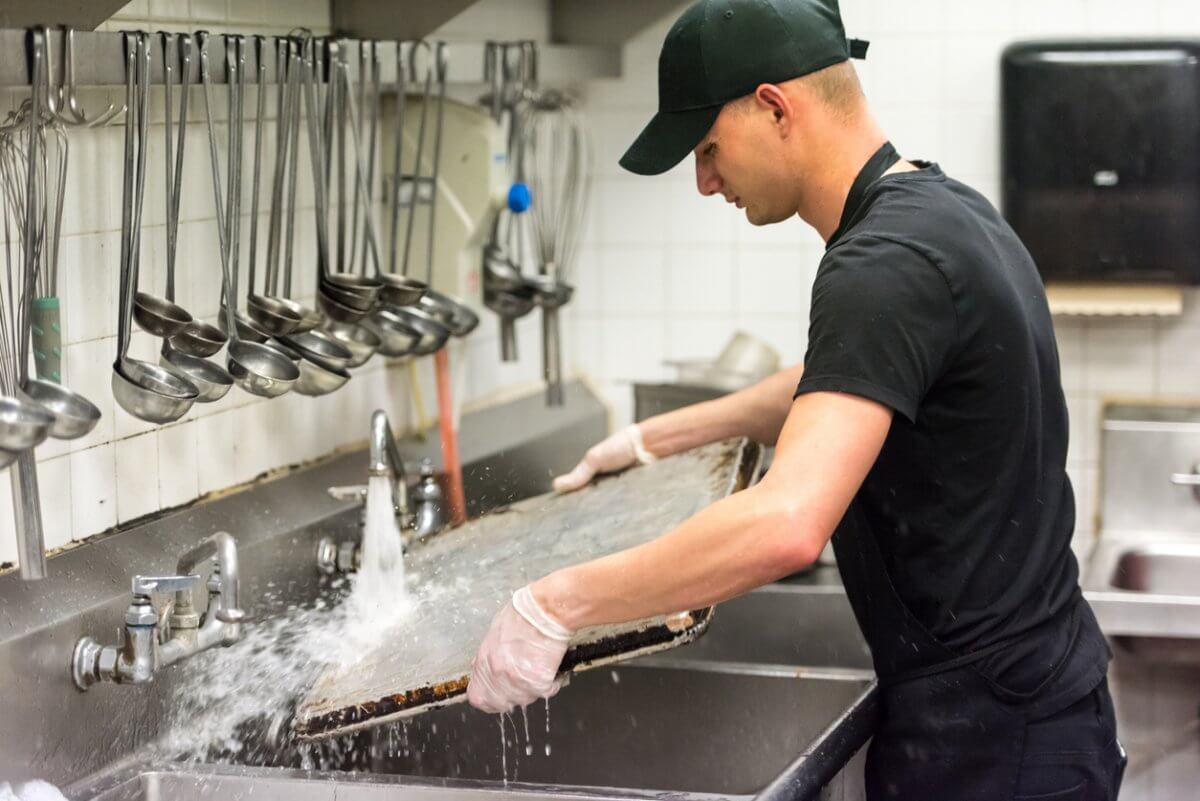What is a grease trap?
A grease trap, sometimes called a grease interceptor, is essentially a container that collects and filters grease and food waste from water going down the sink so that it can safely enter the sewerage system. How grease traps work may vary somewhat by type and configuration, but the end goal is always the same.
As kitchen wastewater enters the grease trap, any food solids generally sink to the bottom while fat, oil, and grease (FOG) float to the top. The cleaner water in between is pumped into a secondary tank then returned to the sewerage system so it can continue on its journey.
What you’re now left with is your first tank containing oil, grease, and fat solids, which build up over time, especially in a busy restaurant. In large volume, they can harden and cause blockages anywhere along the line, either in your plumbing or in the greater wastewater system. It’s to everyone’s benefit, then, that restaurant owners take care to have their grease traps serviced regularly.
A grease trap is designed to intercept greases and solids before they enter the wastewater disposal system. Even normal wastewater has small amounts of oil that enter the system, forming a layer of scum that gets slowly digested by microorganisms.
In a commercial kitchen, large volumes of oil, fat, and cooking grease solidify when cooled and may combine with other solid wastes, clogging your grease trap and causing drainpipe blockages. On top of that, if this congealed fat isn’t cleared away regularly, it can become foul-smelling – or even a health hazard. Not the sort of image you want for your restaurant.
Without frequent grease trap maintenance, waste material builds up, causing your sink to overflow and potentially creating serious plumbing issues. Your grease trap needs regular cleaning.
Here are 5 reasons why you need a grease trap maintenance programme:
1. Poor hygiene and off-putting odours. Like almost anything dirty, a dirty grease trap smells. And even though it’s outside, the smell will waft – particularly problematic if you have a patio. The odour of decomposing grease and food will be what customers first notice when they walk up and may even follow them in the door. Not very appetising.
On top of the very real possibility of lost business, employees will resent having to work in such an unpleasant environment as well as the seeming lack of care by their employer.
2. System-wide plumbing problems. When grease trap cleaning isn’t done regularly, it doesn’t take long before all the grease solidifies into an obstructive mass, causing plumbing issues that could affect your entire drainage system at any time, including your toilets, sinks and drains. And once they get backed up, they smell. Again, not very welcoming, hygienic, or what you’d expect from a business based around food. If you were a customer, would you come back?
3. Costly emergency repairs. When food and grease decompose, as in an uncleaned grease trap, they ferment into sulfuric acid, which is strong enough to burn anything it comes into contact with, including your grease trap. If your other plumbing is affected as well, pipes can become corroded and repairs get very expensive very quickly – particularly if it’s an emergency callout, where plumber rates are even higher. But because your business can’t afford to be out of commission, you’ll have to suck it up and eat that cost.
4. Loss of revenue. If your plumbing problems are severe enough, you may have to close temporarily while the repairs are done. You’ll lose revenue not only from customers not coming in but also stock expiring and salaried employees who continue to be paid. If your restaurant stays closed for long enough, casual employees may be forced to seek work elsewhere. Your competition will be in a position to lure staff away and win customer business you can’t fulfill.
5. Damage to the public sewage system. When dirty grease traps become overwhelmed, toxic waste, including sulfuric acid, can flow into the Auckland wastewater system. Dumping untreated wastewater is likely to attract the attention of regulatory agencies and get your restaurant fined and shut down until the problem has been remedied. And you’ll have to pay for extensive – and expensive – repair work as well! Don’t be that guy.
How does grease trap cleaning work?
To prevent blockages, overflows, and the dumping of toxic waste, accumulated FOGs must be pumped out of your grease trap and safely disposed of. To do this properly, you’ll need to contract the services of a waste management professional like Envirovac. Based in Ellerslie, we look after busy Auckland restaurants and businesses and service the Rodney district as well.
We can provide regular grease trap cleaning services using our powerful sucker truck, connected to a hose that vacuums the oils, fats, and grease out of your grease trap to keep it clean and functioning normally.
How often should your grease trap be cleaned?
As with most things, it depends. For a busy restaurant, we suggest cleaning your grease trap every two to three months for best results but are happy to take a look at your premises and make a custom recommendation. Contact Envirovac on 09 218 5884 today.
